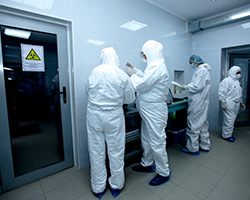Anticipating health workforce and hospital needs to plan for a better COVID-19 response in Kyrgyzstan

WHO
Two WHO tools, developed to forecast requirements for health workforce surge capacity and hospital bed availability during the COVID-19 pandemic, were tailored to fit the context of the response in Kyrgyzstan.
The WHO Adaptt Surge Planning Support Tool and the Health Workforce Estimator helped Kyrgyzstan’s Ministry of Health and Social Development make optimal plans at different stages of the COVID-19 pandemic.
- The Adaptt Surge Planning Support Tool visualizes needs during a surge, including the number of hospital beds, human resources and dates of predicted bed shortages.
- The Health Workforce Estimator identifies workforce gaps by estimating how many of each type of health worker are needed, based on numbers of mild, moderate, severe and critical patients per day.
Piloting the tools in phases
Application of the 2 tools was done in 2 phases. The first phase piloted the tools in 11 hospitals in the Chui region and the capital, Bishkek, using data from 1 October 2020 to 15 February 2021. The results showed a close correlation between predicted and actual hospitalizations and bed requirements, demonstrating their reliability in the Kyrgyz context.
In the second phase, the tools were used to estimate requirements for a third national surge between 18 March and 30 June 2021, applying national and regional data from the second surge in the Chui region and Bishkek. Assuming the third surge in Kyrgyzstan would be 75% of the second surge, the results indicate that the country has enough staff and beds to support the next surge.
Results of the pilot
The Chui region pilot showed that there was a shortage of doctors, nurses and junior health workers at the peak of the second surge and that there are generally more critical patients in the Chui region than there are nationally.
This work, conducted by the Ministry of Health and Social Development to develop a more robust health workforce for hospitals involved in the COVID-19 response, is technically supported by the Working for Health Programme, which is led by WHO and funded by the China-United Nations Peace and Development Fund.



